The article was credited to: Bianca Ffolkes | Yahoo Lifestyle – Thu, Sep 27, 2012 13:16 BST and is reproduced in part below.
My learning log for the second part of this course - Digital Photographic Practice.
Sunday, 30 September 2012
A real, live case!
Promptly in keeping with the subject of the moral & artistic considerations for extreme editing of images, this story appeared on Yahoo News on Thursday the 27th of September 2012. I have shown this article in part. Interesting to see that the decision to edit the photograph in this fashion does not appear to have been the photographer's on this occasion. This adds another dimension to our subject - should you edit other peoples work?
The article was credited to: Bianca Ffolkes | Yahoo Lifestyle – Thu, Sep 27, 2012 13:16 BST and is reproduced in part below.
The article was credited to: Bianca Ffolkes | Yahoo Lifestyle – Thu, Sep 27, 2012 13:16 BST and is reproduced in part below.
Labels:
extra
Tuesday, 25 September 2012
Enhancement
Furthering the investigation into my personal view on altering
images and at which point an innocent edit becomes more than just that, I have
made two more edits.
This is the first time that I felt the edits were starting to go beyond what was actually recorded on the camera. This was then taken way over my personal limit by changing the colour with the ‘tint’ settings, even though the colour still looks natural.
The adjustments I have made to the two images are localised
to the face and eyes only. For this I have used the Adobe Lightroom software
package. One of the tools available is a paintbrush tool which allows an area
to be ‘painted’. This area can then be adjusted with whatever settings you wish
to apply. To soften the transition between the effect and the unaltered image,
an adjustable feathered edge can be applied.
For the first image I have set the brush to adjust exposure
with a soft edge and then painted over the girls face, stopping at the
hairline. I then lifted the exposure to lighten the face. In doing this I have
tried to keep the image looking natural.
For this image I am happy that it still reproduces the girl
faithfully. She did after all look like this and had the light been in a
slightly different place, her face may have been lit the same way.
The second image has built on the first by having the eyes enhanced
further. The the eyes have then been given another colour. This was again done
with the localised brush tool but I reduced the feathering to work on the
smaller area of the pupils. First steps were to increase exposure and contrast.
 |
| Image with the face brightened. |
 |
| Image with face brightened and eyes coloured. |
Labels:
part4
Sunday, 23 September 2012
Tate Modern
Following on from some of the previous exercises, I have converted one of my older film images to black & white. I chose this shot of a new exhibit going up in the Tate Modern, as it has a bit of tonal range.
Similar to an earlier exercise I had to do a bit of dust spot removal. In several instances this did mean having to choose between dust spots and real marks on the floor.
Similar to an earlier exercise I had to do a bit of dust spot removal. In several instances this did mean having to choose between dust spots and real marks on the floor.
Labels:
extra
Wednesday, 19 September 2012
Improvement or interpretation?
The following image has undergone some processing similar to traditional dodging and burning. I have isolated the figure and pallet using the polygonal lasso tool and feathered the edge of the selection by a few pixels in an attempt to soften the edge of the cut-out. Then I have worked with a levels adjustment layer, the objective being to lightening the figure.
I have tried to lighten the figure without the end result looking 'false'. I think this has worked very well.
The exercise is again asking me to consider the limits of this image manipulation. I find the level of work carried out here quite acceptable. Even if I had lightened the figure more, I don't feel it is telling an 'un-truth' although the image will look false. My reasoning for this is that the image is still displayed as it was seen albeit a little lighter.
This is of course all highly subjective. Other photographers my have different opinions. My own opinions differ depending on the final use of the image.
I have tried to lighten the figure without the end result looking 'false'. I think this has worked very well.
 |
| Portrait with selection altered with levels. |
The exercise is again asking me to consider the limits of this image manipulation. I find the level of work carried out here quite acceptable. Even if I had lightened the figure more, I don't feel it is telling an 'un-truth' although the image will look false. My reasoning for this is that the image is still displayed as it was seen albeit a little lighter.
This is of course all highly subjective. Other photographers my have different opinions. My own opinions differ depending on the final use of the image.
Labels:
part4
Monday, 17 September 2012
Cecil Beaton Exhibition
In a previous post I looked at the work of Cecil Beaton. I have just found out that the Imperial War Museum is hosting an exhibition entitled "Cecil Beaton: Theatre of War" which runs from the 6th September 2012 until the 1st January 2013. (link)
I will be making every effort to visit this exhibition!
I will be making every effort to visit this exhibition!
Labels:
extra
Monday, 10 September 2012
Correction
This chapter encourages us to explore the boundaries of what constitutes 'fake' and 'real'.
With modern technology we have complete control over the image that is presented, much more so than with traditional photography. With skill and practice it is possible to create completely fictitious photographic situations. By some this is considered art, others may see it as fraud. To better understand my own feelings on this subject and to find where I myself draw the line between tidying up a picture and distorting the truth, I am editing the following two images from the course web site. The two images provide two different editing situations.
In the first image I am going to clean up dirt spots. As most of the image consists of similar dust marks, I have shown a section of the image at 100%.
My own feelings about this first exercise are feelings of frustration! The photographed objects appear to be of some kind of transparent substance, i.e. glass or resin. The objects have dark marks all over them but it is not clear if these are dust spots or some property of the materials. As I did not photograph the objects and have never seen the real thing, I am finding it very difficult to be sure that some of the dust spots I am correcting are actually dust spots! It can be argued that somebody looking at the end results would have been unaware of the original marks but then they are falling prey to my version of what was in front of the lens.
For the second part of this exercise I have to remove some lens flare, seen on the left hand side of the image below. I have used the clone tool in Photoshop, set to colour to remove as much of the flare as possible.
This was very difficult to carry out as there is not always a clean area to clone from. As before, it is not always possible to see what the underlying colour and texture should be. I spent quite a lot of time doing this and still believe it was not long enough and could have been done better.
What are my thoughts about this though? Well this was slightly easier to work on than the previous shot as it was easier to relate to what is being shown. Removing the flare in this instance has made for a more enjoyable picture. A big part of me still thinks it would have been better to get the shot without the flare, after all, had I made a better job of the cloning would only prove that I am good at Photoshop, not necessarily photography!
With modern technology we have complete control over the image that is presented, much more so than with traditional photography. With skill and practice it is possible to create completely fictitious photographic situations. By some this is considered art, others may see it as fraud. To better understand my own feelings on this subject and to find where I myself draw the line between tidying up a picture and distorting the truth, I am editing the following two images from the course web site. The two images provide two different editing situations.
In the first image I am going to clean up dirt spots. As most of the image consists of similar dust marks, I have shown a section of the image at 100%.
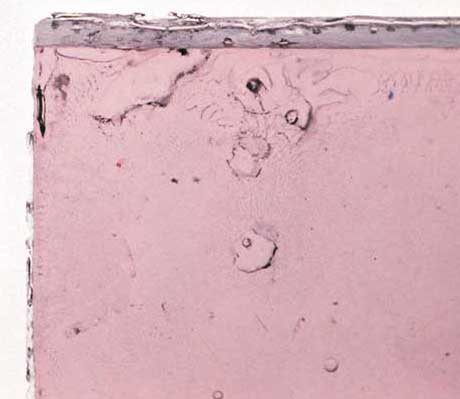 |
| Before clean up with dust spots in place. |
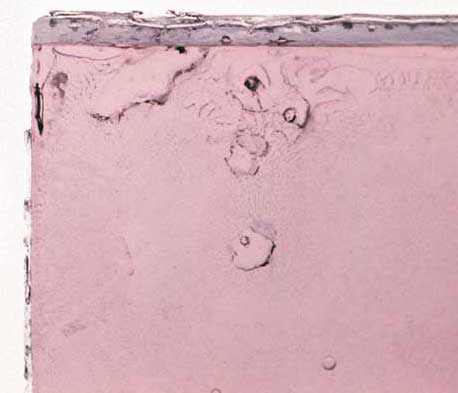 |
| Without dust spots. |
For the second part of this exercise I have to remove some lens flare, seen on the left hand side of the image below. I have used the clone tool in Photoshop, set to colour to remove as much of the flare as possible.
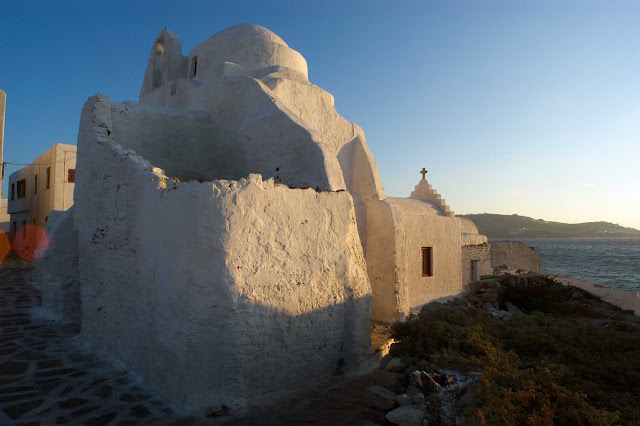 |
| The original image with flare visible on the left. |
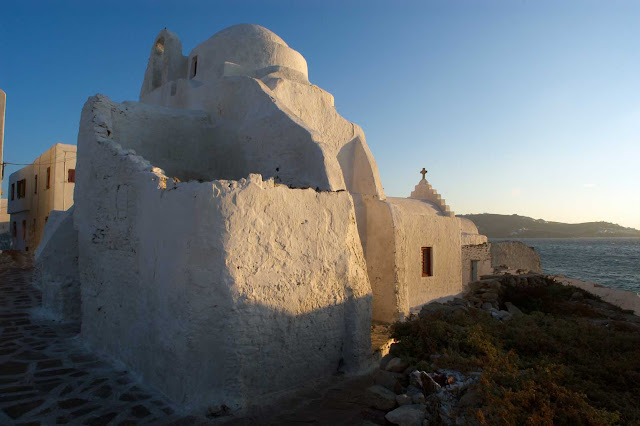 |
| Lens flare removed with clone tool set to colour. |
Labels:
part4
Monday, 27 August 2012
Assignment 3. Monochrome
This assignment is a study in monochrome. From our previous exercises we have learnt that some subjects are better suited to black and white than others. We are looking for different qualities than we would, should we be working in colour. Here the qualities of contrast, tonal range, form and texture become important.
In the lead up to this assignment I have been looking at black and white work from other artists including Harry Callahan, Ansel Adams, Cecil Beaton and Henri Cartier-Bresson. Interesting to see the different subject matters covered in black and white.
Why I have chosen this subect
I have chosen as my subject the pier in Bognor Regis, my home town. I believe the pier offers many opportunities for textures as well as shape and form. Much more than this though, I also feel that the pier is suitable on another level. Most of the piers in England date from around the turn of the previous century. Black and white photography always raises this nostalgic feeling in me. I see a tie between the subject and the medium.
On yet another level, a pier and it's visitors in colour can be a happy and joyful place but when photographed in monochrome and in less than favourable holiday conditions and the emptiness can take on a melancholy atmosphere. This is what I am setting out to capture in the following images.
Conclusion
My objective was to show a moody, melancholy side of the pier. The pier is definitely moodier in black and white than when you look at the colour versions of the photographs. Looking at the images now, I feel that I have one very cliché image (it should be obvious which one!). Maybe the weather could have been a bit more 'moody' but I made several visits to the pier and in the end had to go with what I had captured.
I am quite happy with the processing. Black and white manipulation is something I haven't carried out often. There seemed to be a big craze in the last couple of years and I hate to follow the crowds, so I deliberately avoided this genre. This exercise forced me to experiment with black and white and I did enjoy it.
Picture details
Clutter. Canon EOS 5D MKII, 35mm Lens, 1/100 @F11, iso 50.
Pier time. Canon EOS 5D MKII, 35mm Lens, 1/250 @F8, iso 50.
My shadow. Canon EOS 5D MKII, 35mm Lens, 1/2500 @F2, iso 50.
Walk the plank. Canon EOS 5D MKII, 35mm Lens, 1/100 @F8, iso 50.
Holiday spirit. Canon EOS 5D MKII, 50mm Lens, 1/30 @F16, iso1000.
Under the board walk. Canon EOS 5D MKII, 50mm Lens, 1/160 @ F2.8, iso 1000.
Wish you were here. Canon EOS 5D MKII, 50mm Lens, 1/500 @ F5.6, iso50.
Finally, below are a small sample of the images that I took for this assignment.
In the lead up to this assignment I have been looking at black and white work from other artists including Harry Callahan, Ansel Adams, Cecil Beaton and Henri Cartier-Bresson. Interesting to see the different subject matters covered in black and white.
Why I have chosen this subect
I have chosen as my subject the pier in Bognor Regis, my home town. I believe the pier offers many opportunities for textures as well as shape and form. Much more than this though, I also feel that the pier is suitable on another level. Most of the piers in England date from around the turn of the previous century. Black and white photography always raises this nostalgic feeling in me. I see a tie between the subject and the medium.
On yet another level, a pier and it's visitors in colour can be a happy and joyful place but when photographed in monochrome and in less than favourable holiday conditions and the emptiness can take on a melancholy atmosphere. This is what I am setting out to capture in the following images.
 |
| Clutter. |
 |
| Pier time. |
 |
| My shadow. |
 |
| Walk the plank. |
 |
| Holiday spirit. |
 |
| Under the board walk. |
 |
| Wish you were here.... |
My objective was to show a moody, melancholy side of the pier. The pier is definitely moodier in black and white than when you look at the colour versions of the photographs. Looking at the images now, I feel that I have one very cliché image (it should be obvious which one!). Maybe the weather could have been a bit more 'moody' but I made several visits to the pier and in the end had to go with what I had captured.
I am quite happy with the processing. Black and white manipulation is something I haven't carried out often. There seemed to be a big craze in the last couple of years and I hate to follow the crowds, so I deliberately avoided this genre. This exercise forced me to experiment with black and white and I did enjoy it.
Picture details
Clutter. Canon EOS 5D MKII, 35mm Lens, 1/100 @F11, iso 50.
Pier time. Canon EOS 5D MKII, 35mm Lens, 1/250 @F8, iso 50.
My shadow. Canon EOS 5D MKII, 35mm Lens, 1/2500 @F2, iso 50.
Walk the plank. Canon EOS 5D MKII, 35mm Lens, 1/100 @F8, iso 50.
Holiday spirit. Canon EOS 5D MKII, 50mm Lens, 1/30 @F16, iso1000.
Under the board walk. Canon EOS 5D MKII, 50mm Lens, 1/160 @ F2.8, iso 1000.
Wish you were here. Canon EOS 5D MKII, 50mm Lens, 1/500 @ F5.6, iso50.
Finally, below are a small sample of the images that I took for this assignment.
 |
|
|
Sunday, 12 August 2012
A look at "Unseen Vogue"
As I have mentioned before, many of the photographers I admire have at some time worked as fashion photographers. I was recently looking through the photography book section of Amazon when 'Unseen Vogue' (Little, Brown. 2002) caught my attention. What is 'Unseen Vogue'? It sounds interesting!
The description for the book read "For every picture that has been published in Vogue, there are many that never make it - not because of poor composition or execution, but because the fashion styling may have been too inventive, the camera technique too pioneering or, frequently, because the magazine simply ran out of space"
This was tantalising enough so I ordered the book immediately and it duly arrived a few days later.
I was not disappointed. The book has turned out to be much more relevant to the course than I expected. Between the pages we find work from many of the great masters - Horst, George Hoyningen-Huene, Cecil Beaton, Lee Miller, Barry Lategan, Corinne Day, David Bailey and Helmut Newton as well as others that I will be researching further. As the description states this book contains pictures that didn't make it in to Vogue. It is incredibly interesting to see this work and the reasons for this decision. Many of the pages also contain contact sheets so we can get a view of the different poses and ideas the photographers, models and art directors have tried.
Further to all these gems, there are also notes and letters of conversations between Vogue editors and photographers. Finally, you get to see some new shots of some of our greatest models going back to the beginning of Vogue.
All in all this is a great photographers book if you have the slightest interest in fashion photography.
Little, Brown. 2002. ISBN 978-0-316-72766-2
The description for the book read "For every picture that has been published in Vogue, there are many that never make it - not because of poor composition or execution, but because the fashion styling may have been too inventive, the camera technique too pioneering or, frequently, because the magazine simply ran out of space"
This was tantalising enough so I ordered the book immediately and it duly arrived a few days later.
I was not disappointed. The book has turned out to be much more relevant to the course than I expected. Between the pages we find work from many of the great masters - Horst, George Hoyningen-Huene, Cecil Beaton, Lee Miller, Barry Lategan, Corinne Day, David Bailey and Helmut Newton as well as others that I will be researching further. As the description states this book contains pictures that didn't make it in to Vogue. It is incredibly interesting to see this work and the reasons for this decision. Many of the pages also contain contact sheets so we can get a view of the different poses and ideas the photographers, models and art directors have tried.
Further to all these gems, there are also notes and letters of conversations between Vogue editors and photographers. Finally, you get to see some new shots of some of our greatest models going back to the beginning of Vogue.
All in all this is a great photographers book if you have the slightest interest in fashion photography.
Little, Brown. 2002. ISBN 978-0-316-72766-2
Labels:
extra
RAW
The advantages of using RAW for image capture are generally accepted to be the ability to carry out non destructive and post acquisition editing which allows us to hold the image quality until a later stage of the image processing cycle.
This exercise is to put in to perspective how noticeable this benefit actually is in real terms.
I have captured three images with different lighting set-ups. Each image has been captured as a RAW file as well as a JPEG (at highest quality). On my camera I am able to do this simultaneously, so both files will have identical lighting etc. To minimise the amount of post processing, I have set the camera up to give the best possible image at the time of shooting, i.e. white balance, exposure etc.
The first two images were taken in a local church yard. Very little tweaking was required on the RAW file. A little more was required for the jpeg as there was still a slight colour and brightness difference compared to the RAW version.
Comparing the two images at all stages I noticed the following. As previously mentioned the jpg file was slightly different to the RAW, straight out of the camera. The jpeg was darker and colder than the RAW. Some adjustment to the brightness, contrast and colour curves brought the two images into line.
After this work I examined both images at 100%. I checked for the presence of fringing around the edges of shapes and noise in the darker areas of the image. This image has a very shallow depth of field which allowed me to examine both sharp and soft area's.
An examination at 100% did not really reveal anything that I would worry about. There was no fringing and the noise in the darker areas was no worse than in the RAW version of the file. In the two images above you are able to see the slight difference in the colour tone but as both pictures have been converted to Jpeg, it is naturally not possible to see the differences between RAW and Jpeg. In this lighting situation the dynamic range of both shots is the same.
Image pair number two were shot in artificial light. For this I used a two flash-gun set-up with the main light to the left of the camera through a shoot through umbrella and the second flash to the right with no modifier except the flip down diffuser on the front of the flash. The camera was set to flash white balance and tripod mounted.
Again there were differences to the Jpeg and RAW files as they came from the camera. The Jpeg was again a flatter image and needed a bit more adjustment to brightness and contrast. In my images there was very little tolerance when adjusting the contrast. There was very little adjustment to be had between the highlight clipping warning and the shadow clipping warning. This was apparent in the white of the flowers and the black of background.
Again an examination at 100% showed very little to be concerned about with regards to the image quality. I paid particular attention to the edges of the white flower petals against the black background. It will be interesting to see if this is the case with the last two images!
There are two more images needed to complete this exercise, which will be high contrast.
This exercise is to put in to perspective how noticeable this benefit actually is in real terms.
I have captured three images with different lighting set-ups. Each image has been captured as a RAW file as well as a JPEG (at highest quality). On my camera I am able to do this simultaneously, so both files will have identical lighting etc. To minimise the amount of post processing, I have set the camera up to give the best possible image at the time of shooting, i.e. white balance, exposure etc.
The first two images were taken in a local church yard. Very little tweaking was required on the RAW file. A little more was required for the jpeg as there was still a slight colour and brightness difference compared to the RAW version.
 |
| Jpeg from RAW file. |
 |
| Edited Jpeg. |
After this work I examined both images at 100%. I checked for the presence of fringing around the edges of shapes and noise in the darker areas of the image. This image has a very shallow depth of field which allowed me to examine both sharp and soft area's.
An examination at 100% did not really reveal anything that I would worry about. There was no fringing and the noise in the darker areas was no worse than in the RAW version of the file. In the two images above you are able to see the slight difference in the colour tone but as both pictures have been converted to Jpeg, it is naturally not possible to see the differences between RAW and Jpeg. In this lighting situation the dynamic range of both shots is the same.
Image pair number two were shot in artificial light. For this I used a two flash-gun set-up with the main light to the left of the camera through a shoot through umbrella and the second flash to the right with no modifier except the flip down diffuser on the front of the flash. The camera was set to flash white balance and tripod mounted.
Again there were differences to the Jpeg and RAW files as they came from the camera. The Jpeg was again a flatter image and needed a bit more adjustment to brightness and contrast. In my images there was very little tolerance when adjusting the contrast. There was very little adjustment to be had between the highlight clipping warning and the shadow clipping warning. This was apparent in the white of the flowers and the black of background.
Again an examination at 100% showed very little to be concerned about with regards to the image quality. I paid particular attention to the edges of the white flower petals against the black background. It will be interesting to see if this is the case with the last two images!
 |
| RAW Conversion. |
 |
| Edited Jpeg. |
Labels:
part3
Tuesday, 7 August 2012
Thinking about assignment three - continued.
I have had feedback from my tutor which includes the recommendation to look at the work of Harry Callahan (1912 - 1999) prior to starting my next assignment. I found a slideshow of some of his photography here and an interview with Harry Callahan here.
Harry Callahan, by his own confession, caught the photography bug after attending a workshop run by Ansel Adams in the 1940's. Callahan worked in both colour and black and white photographing his primary subjects of the city, nature and his wife and daughter. To keep his work from getting stale, he would switch subject and camera when he started to tire from the theme he was working on.
Callahan also used 'in camera' multiple exposure and camera movement techniques in his work. Below are some examples of Harry Callahan's (black & white) photography.
To get a better overall view of his images, I carried out a Google Image search. I have seen it written that Callahan has a strong sense of line. This is apparent if you view his images side by side and is evident in all the images below, be it the silhouette or the architectural shots. Another good example is 'Chicago, 1961' which has strong uprights in the lamp post, the figure in the foreground through to the chimney, side of building and other pedestrians. Moody tones are also evident in all the images - note that I am only looking at the black & white work in this essay as a prelude to the black and white assignment.
Other photographs with great tonal qualities to look out for are the series of pebbles in sand and a favourite of mine, 'Untitled, ca 1953' which depicts the fingers of a hand curling round the top of a table.
Harry Callahan, by his own confession, caught the photography bug after attending a workshop run by Ansel Adams in the 1940's. Callahan worked in both colour and black and white photographing his primary subjects of the city, nature and his wife and daughter. To keep his work from getting stale, he would switch subject and camera when he started to tire from the theme he was working on.
Callahan also used 'in camera' multiple exposure and camera movement techniques in his work. Below are some examples of Harry Callahan's (black & white) photography.
To get a better overall view of his images, I carried out a Google Image search. I have seen it written that Callahan has a strong sense of line. This is apparent if you view his images side by side and is evident in all the images below, be it the silhouette or the architectural shots. Another good example is 'Chicago, 1961' which has strong uprights in the lamp post, the figure in the foreground through to the chimney, side of building and other pedestrians. Moody tones are also evident in all the images - note that I am only looking at the black & white work in this essay as a prelude to the black and white assignment.
 |
| Eleanor, 1948 |
 |
| Chicago, 1961 |
 |
| Cape Cod, 1972 |
 |
| Cape Cod, 1972 |
 |
| Eleanor and Barbara, Chicago, 1954 |
 |
| Chicago, 1949 |
Labels:
assignment3,
extra
Wednesday, 11 July 2012
Thinking about assignment three.
As I am working on the last exercise before assignment three, I have started to think about what I am going to photograph for the assignment. This is a monochrome task so building on the last exercises in part three I have started to look for a subject that will allow me the maximum of scope to show form, tonal contrast and texture. I also want the subject to be easily accessible so that I can visit it on more than one occasion should I need to.
So far I am considering two ideas. The first is the local pier. This gives the opportunity of pattern and rhythm as well as tonal variation in repetitive constructs such as the deck planking and railings, the pier legs etc. To bring variety there is also the tonal range of the sky if I photograph this in a manner that it forms part of a pier view and choose the right time to do it.
My second thought is a little more abstract but something I will investigate. This will be a series of photographs of one of the pedestrian bridges across a nearby A road. Might sound a bit strange but it has some great shapes. My only concern is being able to get enough variation across 5 to 10 images.
Labels:
assignment3,
extra
Wednesday, 4 July 2012
Catharine Portfolio Shoot
I did some more portfolio photography with Catharine last weekend. The location was an old ruin not too far from where I live. The idea was to get the shots as 'fashion' looking as possible.
Catharine had three outfits and a number of accessories. For my part I paid a lot of attention to the lighting. I was using a Strobist set-up of a shoot through umbrella with a remotely fired flash gun. As part of getting the look, I set the lights to eliminate quite a lot of the shadows on the face and aimed to also get a fairly even lighting across Catharine.
Final touches were carried out in post production. The colours were slightly de-saturated and a certain amount of toning has been added.
My influences for this type of work come from magazines such as Vogue and Harper's Bazaar as well as the online work of many fashion photographers.
Catharine had three outfits and a number of accessories. For my part I paid a lot of attention to the lighting. I was using a Strobist set-up of a shoot through umbrella with a remotely fired flash gun. As part of getting the look, I set the lights to eliminate quite a lot of the shadows on the face and aimed to also get a fairly even lighting across Catharine.
Final touches were carried out in post production. The colours were slightly de-saturated and a certain amount of toning has been added.
My influences for this type of work come from magazines such as Vogue and Harper's Bazaar as well as the online work of many fashion photographers.
Labels:
extra
Friday, 29 June 2012
Black and white
For this post I am not going to talk about the processing of the image as this was done in much the same manner as the black and white processing in previous exercises.
This shot was set up with two camera flash guns fired by radio triggers placed to the left and right of the fruit bowl. The bowl is filled with a variety of different fruits each with particular textures. To add further interest to the shot, the bowl itself and the table introduce further textures.
By choosing the fruit and the table, I am trying to emphasize the qualities of line, shape, form and texture. There is textual variety between the plumbs, peach and lemon skins. For line we have the edges of the table and the grain in the wood. The round shapes of the fruit are good solid primitive forms that are well defined by the contrasty unmodified light. The varying secularity of the different fruits also helps to define form. The light rim of the bowl near the bottom edge of the picture is contrasted against the shadow cast by the same.
I think I maybe should have framed the shot a bit tighter - I have already cropped it down to lose some distracting features in the background. Exposure in this situation is partially dictated by the use of the flash units.
This shot was set up with two camera flash guns fired by radio triggers placed to the left and right of the fruit bowl. The bowl is filled with a variety of different fruits each with particular textures. To add further interest to the shot, the bowl itself and the table introduce further textures.
 |
| 1/250, F4, ISO100 37mm. |
I think I maybe should have framed the shot a bit tighter - I have already cropped it down to lose some distracting features in the background. Exposure in this situation is partially dictated by the use of the flash units.
Labels:
part3
Monday, 18 June 2012
Colours into tones 2
In this exercise I have attempted to increase the 'depth' of a photograph by working on the tonal range of the skies. The workbook suggests that I take a landscape photograph but as the weather has been so bad, I have had to select an image from my existing captures. The picture I have chosen does have the characteristics that I would have aimed for, i.e. a wide angle shot with a good sky and some foreground interest.
The first image serves as a reference image. This is a straight conversion to black and white in the software with default settings. The end result is again a fairly flat image. The blackest blacks are not totally black although there are some proper whites.
Here is the default conversion...
To create a more interesting shot and one that fulfils the brief, I have started with the default conversion and further worked this. After some initial tweaking of the contrast and blacks and whites to enhance the image, I set to work on the skies.
To create the depth I really needed to draw the eye to the sky area and emphasize the cloud layers. Most of this was achieved by working on the blue and aqua sliders. After some adjustment I was able to return to the exposure slider to brighten the image back up again. This allowed further tweaking of the image.
The end result can be seen below.
Much as in the previous exercise, I was able to push the processing a very large amount. We are again deviating from reality but in black and white this seems more acceptable.
The first image serves as a reference image. This is a straight conversion to black and white in the software with default settings. The end result is again a fairly flat image. The blackest blacks are not totally black although there are some proper whites.
Here is the default conversion...
 |
| A default conversion by the software. |
To create the depth I really needed to draw the eye to the sky area and emphasize the cloud layers. Most of this was achieved by working on the blue and aqua sliders. After some adjustment I was able to return to the exposure slider to brighten the image back up again. This allowed further tweaking of the image.
The end result can be seen below.
 |
| Conversion to emphasise depth. |
Much as in the previous exercise, I was able to push the processing a very large amount. We are again deviating from reality but in black and white this seems more acceptable.
Labels:
part3
Thursday, 7 June 2012
Colours into tones 1
The original image used in this exercise was taken with my film camera and colour negative film. I then scanned the negative into the computer which resulted in these lovely vivid colours. This provides the perfect tonal range for this experiment where we will be lightening and darkening the grey scale tones of the dominant colours, in this case, blue and yellow.
Before starting work on the individual colour tones, I have carried out a standard black and white conversion using the software defaults. The software conversion is very safe but not very exciting and can be seen below. This will serve as our reference image.
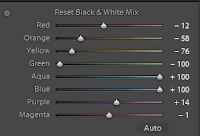 The first edit (below) emphasises the yellow tones and subdues the blue areas. As can be seen by the inset settings panel, several sliders have been adjusted to maximise the effect. Yellow, green and orange have all been reduced to darken the yellow tones. The blue and aqua have been increased to maximum to lighten the sky area. The resulting image can be seen below. It has been necessary to adjust more than just the main colour as different shades start to spill over into other colours.
The first edit (below) emphasises the yellow tones and subdues the blue areas. As can be seen by the inset settings panel, several sliders have been adjusted to maximise the effect. Yellow, green and orange have all been reduced to darken the yellow tones. The blue and aqua have been increased to maximum to lighten the sky area. The resulting image can be seen below. It has been necessary to adjust more than just the main colour as different shades start to spill over into other colours.
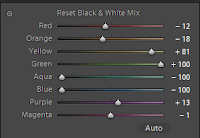 To reverse the tonal range from above I have now minimised the blue and aqua controls and increased the yellow and greens. This has produced the strong 'negative', almost 'infra-red' style image below. Note how the sky area in the image above is much larger than the equivalent dark sky area below. In both conversions I have tried to get the contrasts as extreme as possible without losing any detail. I have allowed a tiny amount of clipping in both the blacks and the whites.
To reverse the tonal range from above I have now minimised the blue and aqua controls and increased the yellow and greens. This has produced the strong 'negative', almost 'infra-red' style image below. Note how the sky area in the image above is much larger than the equivalent dark sky area below. In both conversions I have tried to get the contrasts as extreme as possible without losing any detail. I have allowed a tiny amount of clipping in both the blacks and the whites.
Conclusion.
Creatively there is a major difference between these two images. The image with the darkened yellow tones is maybe a little extreme but nether-the-less still a realistic black and white rendering of the original. The picture with the darkened blue sky is abstract and surreal. Here we have changed the meaning of this image from an unusual view of a group of trees to something other-worldly.
 |
| The original image. |
 |
| A standard black and white conversion by the software. |
 The first edit (below) emphasises the yellow tones and subdues the blue areas. As can be seen by the inset settings panel, several sliders have been adjusted to maximise the effect. Yellow, green and orange have all been reduced to darken the yellow tones. The blue and aqua have been increased to maximum to lighten the sky area. The resulting image can be seen below. It has been necessary to adjust more than just the main colour as different shades start to spill over into other colours.
The first edit (below) emphasises the yellow tones and subdues the blue areas. As can be seen by the inset settings panel, several sliders have been adjusted to maximise the effect. Yellow, green and orange have all been reduced to darken the yellow tones. The blue and aqua have been increased to maximum to lighten the sky area. The resulting image can be seen below. It has been necessary to adjust more than just the main colour as different shades start to spill over into other colours. |
| Darkened yellow tones. |
 To reverse the tonal range from above I have now minimised the blue and aqua controls and increased the yellow and greens. This has produced the strong 'negative', almost 'infra-red' style image below. Note how the sky area in the image above is much larger than the equivalent dark sky area below. In both conversions I have tried to get the contrasts as extreme as possible without losing any detail. I have allowed a tiny amount of clipping in both the blacks and the whites.
To reverse the tonal range from above I have now minimised the blue and aqua controls and increased the yellow and greens. This has produced the strong 'negative', almost 'infra-red' style image below. Note how the sky area in the image above is much larger than the equivalent dark sky area below. In both conversions I have tried to get the contrasts as extreme as possible without losing any detail. I have allowed a tiny amount of clipping in both the blacks and the whites. |
| Darkened blue tones. |
Creatively there is a major difference between these two images. The image with the darkened yellow tones is maybe a little extreme but nether-the-less still a realistic black and white rendering of the original. The picture with the darkened blue sky is abstract and surreal. Here we have changed the meaning of this image from an unusual view of a group of trees to something other-worldly.
Labels:
part3
Wednesday, 6 June 2012
Hotel room.
Some time ago I looked at the artist Stephen Shore. I am interested in his 'deadpan' style of photography. Here is one of my attempts to photograph in the same style.
The picture was shot on 35mm film in natural light, hand held. The location is a hotel room in Gent, Belgium.
I am very happy with the shot. I love the colours which are pretty much how the camera took them. I am aware of, and don't really mind about the burnt out window.
The picture was shot on 35mm film in natural light, hand held. The location is a hotel room in Gent, Belgium.
I am very happy with the shot. I love the colours which are pretty much how the camera took them. I am aware of, and don't really mind about the burnt out window.
Labels:
extra
Strength of interpretation
"The removal of the element of colour, and with it the implication of reproducing reality, has a useful and interesting effect on processing". So says the exercise book. In this task we are going to experiment with this idea and see what differences there are between processing a colour file and the same file in black and white.
I am going to process two of my files, one that I feel suitable for a high contrast treatment and another for a high or low key treatment.
The first image of a graffiti artist in Belgium has been given a very high contrast treatment.This was achieved with curves in an 'S' pattern suggested by the work book. I set the contrast so high that we lose some detail in the darkest blacks, the artist's trousers, and also in the highlights. This is easiest seen in the artist's fore-arm.
I then did a conversion to black and white and again worked with the curves. To get some measure of how much difference there was, I converted the processed colour image and applied still further contrast by using curves once more. I pushed the black and white version to an equal level as the colour one.
When I compare the two images I find that the black and white version could still represent a true picture. It is maybe a little too contrasty but considering the amount of contrast that has been applied, it doesn't look too un-realistic. The colour version is quite obviously over processed - although this may not be wrong if this is what the artist desired. This over processing has affected the realism of the image, visible most prominently in areas we can relate too, such as the boy's skin tones. The colouring has rendered this image near to a piece of 'pop art'.
The second image has been given a low key effect by using curves to shift the brightness range into the darker part of the histogram. After the curves shift I have also used the exposure slider to shift the brightness further. In the black and white image I was able to add more exposure shift than in the colour version.
The further shift does also appear to have affected the contrast in the image. In particular compare the mid range exposure in the colour and black and white image. Once again the realism of the colour image has suffered whereas the black and white image does still seem 'real'.
Conclusion
I realised during this exercise that a big part of this learning process was actually in the selecting of suitable images which in turn will influence the choice of subject when shooting in black and white. Looking through all my images it was surprisingly difficult to find two that were right for this task. During the search I did try quick black and white conversions on many candidates and it was interesting to see the differences in the end results.
The second point raised by the exercise was that a black and white image can be processed to a higher degree than a colour one, without losing realism. I did indeed find this to be the case even if in this exercise I may have exaggerated the over processing a bit!
Finally, this exercise has highlighted that the black and white image is about shade, form and tone, properties that the colour in a colour image may distract from.
I am going to process two of my files, one that I feel suitable for a high contrast treatment and another for a high or low key treatment.
The first image of a graffiti artist in Belgium has been given a very high contrast treatment.This was achieved with curves in an 'S' pattern suggested by the work book. I set the contrast so high that we lose some detail in the darkest blacks, the artist's trousers, and also in the highlights. This is easiest seen in the artist's fore-arm.
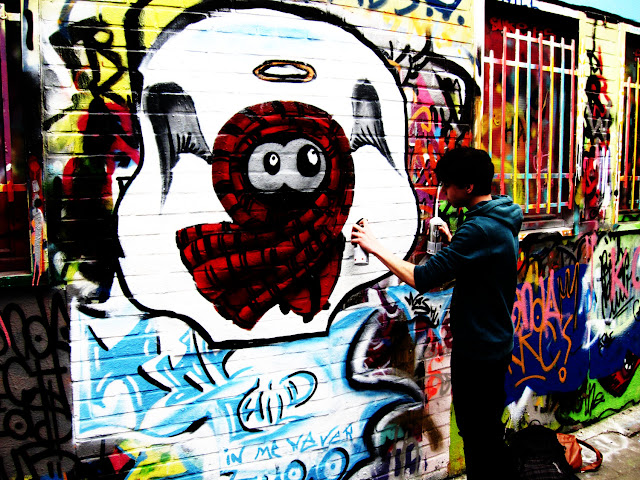 |
| A strong increase in contrast. |
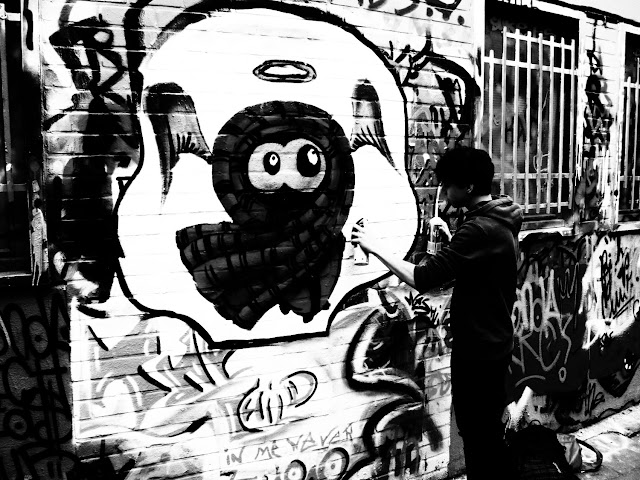 |
| Black and white conversion and further curves applied. |
The second image has been given a low key effect by using curves to shift the brightness range into the darker part of the histogram. After the curves shift I have also used the exposure slider to shift the brightness further. In the black and white image I was able to add more exposure shift than in the colour version.
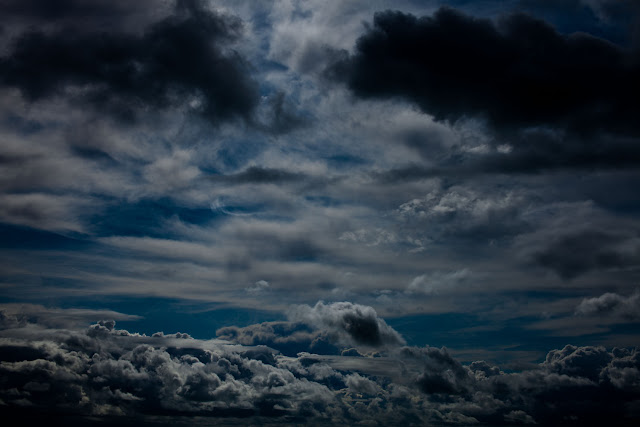 |
| Using curves to shift the brightness range down the scale. |
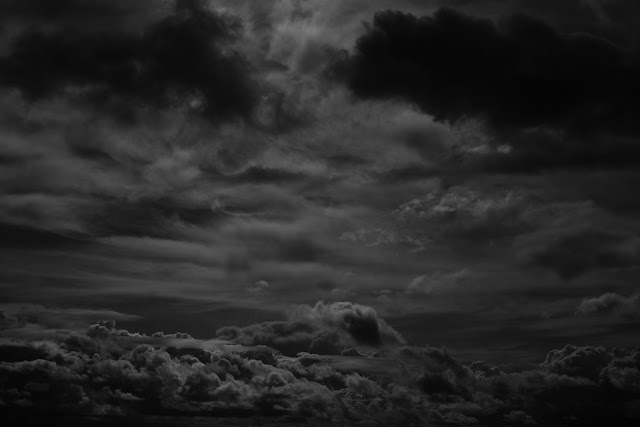 |
| Black and white conversion with brightness range shifted. |
I realised during this exercise that a big part of this learning process was actually in the selecting of suitable images which in turn will influence the choice of subject when shooting in black and white. Looking through all my images it was surprisingly difficult to find two that were right for this task. During the search I did try quick black and white conversions on many candidates and it was interesting to see the differences in the end results.
The second point raised by the exercise was that a black and white image can be processed to a higher degree than a colour one, without losing realism. I did indeed find this to be the case even if in this exercise I may have exaggerated the over processing a bit!
Finally, this exercise has highlighted that the black and white image is about shade, form and tone, properties that the colour in a colour image may distract from.
Labels:
part3
Monday, 28 May 2012
A look at Cecil Beaton
I picked up a book about the photographer Cecil Beaton CBE (January 1904 – January 1980) in a second hand bookshop a little while back. The book tells the story Beaton's life in the first section and then a has great many plates that span his whole career. I was surprised at how experimental and modern some of the photographic concepts appear. His early images of sisters Baba (Barbara) and Nancy show an interest in costume and elaborately designed set-ups. In later years Beaton is to win awards for his costume designs for the films 'My Fair Lady' and 'Gigi'.
Beaton has been a photographer for British vogue and Vanity Fair. He is also well known for his society and Hollywood Star portraits. Beaton also photographed the Royal Family on numerous occasions.
During the early war years Beaton was employed by the Ministry of Information to document the war on the home front. One of his images, a young girl clutching her teddy bear and recovering in hospital after a German bombing raid, was used in the world wide press. Images like this would eventually cause the American Government to join the war.
I thought this look at Beaton might be quite relevant to this module for a number of reasons. There is naturally a great deal of black and white photography which provides for a good study of tones. Equally interesting is his composition and use of props. It is also often mentioned that Beaton was not the most technically adept of photographers and examining the reason for these comments could be useful.
Beaton has been an influence on photographers such as David Bailey and Angus McBean.
A Google image search revealed a good cross section of Cecil Beaton's work.
Ref: Beaton, James Danziger Octopus Books, 1980, ISBN 0 7064 2663 0
Beaton has been a photographer for British vogue and Vanity Fair. He is also well known for his society and Hollywood Star portraits. Beaton also photographed the Royal Family on numerous occasions.
During the early war years Beaton was employed by the Ministry of Information to document the war on the home front. One of his images, a young girl clutching her teddy bear and recovering in hospital after a German bombing raid, was used in the world wide press. Images like this would eventually cause the American Government to join the war.
I thought this look at Beaton might be quite relevant to this module for a number of reasons. There is naturally a great deal of black and white photography which provides for a good study of tones. Equally interesting is his composition and use of props. It is also often mentioned that Beaton was not the most technically adept of photographers and examining the reason for these comments could be useful.
Beaton has been an influence on photographers such as David Bailey and Angus McBean.
A Google image search revealed a good cross section of Cecil Beaton's work.
 |
| Baba, Wanda Baillie-Hamilton and Lady Bridget Poullett, 1928, showing creative use of props. |
 |
| Eileen Dunne in the hospital for sick children 1940. |
 |
| Marlene Dietrich, 1935 |
 |
| Fashion, c1950's |
Labels:
extra
Wednesday, 23 May 2012
Interpretative processing
Following on from our realistic processing in the previous exercise, we now have the freedom to process an image to our creative desire. From one image we are to create three different interpretations.
I have have started by creating a list of styles and looks that have come to mind whilst thinking about this exercise. They are as follows:
I looked through my images and chose the one below. I have processed this one before but thought it would be good to start again from scratch. Therefore the image below is the original Raw converted to Jpeg with all its previous processing removed. This serves as our base reference picture.
The first edit is in Martin Parr style. For this I am going to increase the saturation and contrast as a starting point. In Lightroom I have made a virtual copy so that I can keep all the different edits separate. The processing carried out to achieve this effect was as follows: warm up with manual white balance, increase the contrast,increase blacks,increase saturation in HSL and finally re-adjust the white balance again.
After finishing this edit I looked through a series of Martin parr images again. I am pleased with how this came out and think it achieved what I set out to do. I am not happy with the sky though. This really needs cropping out as it looks grubby. I did attempt to give it a graduated blue filter but this didn't help. For completeness I have included the cropped version at the end of this exercise.
For my next interpretation I have chosen classic black & white processing. I would like this image to represent a traditional black and white photograph as opposed to a black & white version of a colour image. To aid with this I have cropped the image to a square format, resembling a medium format 2 1/4 inch square camera.
I spent some time in my RAW processor with various settings and achieved the following. Briefly, I started out setting the white balance and exposure and then worked on various colour channels. I found I had to re-set the exposure several more times during the process. Finally I added some grain.
I am very happy with the result and think it does look like an old photograph. I do have one issue with the finished photograph though. The grain is very unrealistic and I may have overdone the quantity a bit.
For my final edit I am processing the image as softly as possible to make it look like a water colour picture. In Photoshop, this is fairly easy to achieve with post processing. My interpretation of the brief is that I need to try and achieve this during the RAW conversion so will not have the luxury of post processing. Therefore I will try and get this effect using solely Lightroom.
The characteristics of the type of image I am trying to create are soft, pastel colours with'blocked out' details.
I kept the same crop as above and after a lot of playing around, this is what I came up with.
As mentioned, I know I would have been able to get it closer to a painting in Photoshop but this has all been done in the RAW processor. It took a lot of adjustments but generally speaking the effect is based on softening and blurring. Even though the image is not quite as painterly as I had hoped for, I am still pleased I managed to get this end result.
Finally, below is the cropped Martin Parr style image.
I have have started by creating a list of styles and looks that have come to mind whilst thinking about this exercise. They are as follows:
- Bold and crash colouring in the style of Martin Parr. Highly saturated and contrasty images. Push the primary colours.
- Gritty Reality used by various artists. Highly sharpened images that take on a look as if they have been drawn.
- Black & white, a classic style.
- Desaturated and softened like a watercolour painting.
I looked through my images and chose the one below. I have processed this one before but thought it would be good to start again from scratch. Therefore the image below is the original Raw converted to Jpeg with all its previous processing removed. This serves as our base reference picture.
 |
| The original image. 1/8000 @ F1.8, ISO 100, EF85mm. |
 |
| Martin Parr style. |
For my next interpretation I have chosen classic black & white processing. I would like this image to represent a traditional black and white photograph as opposed to a black & white version of a colour image. To aid with this I have cropped the image to a square format, resembling a medium format 2 1/4 inch square camera.
I spent some time in my RAW processor with various settings and achieved the following. Briefly, I started out setting the white balance and exposure and then worked on various colour channels. I found I had to re-set the exposure several more times during the process. Finally I added some grain.
 |
| Old school black & white. |
For my final edit I am processing the image as softly as possible to make it look like a water colour picture. In Photoshop, this is fairly easy to achieve with post processing. My interpretation of the brief is that I need to try and achieve this during the RAW conversion so will not have the luxury of post processing. Therefore I will try and get this effect using solely Lightroom.
The characteristics of the type of image I am trying to create are soft, pastel colours with'blocked out' details.
I kept the same crop as above and after a lot of playing around, this is what I came up with.
 |
| A painterly effect. |
Finally, below is the cropped Martin Parr style image.
 |
| Martin Parr style cropped. |
Labels:
part3
Subscribe to:
Comments (Atom)





